Dipsacus laciniatus (Cut-leaf Teasel)
| Also known as: | |
|---|---|
| Genus: | Dipsacus |
| Family: | Dipsacaceae (Teasel) |
| Life cycle: | biennial, short-lived perennial |
| Origin: | Europe |
| Status: |
|
| Habitat: | part shade, sun; moist; roadsides, ditches, open fields, waste areas |
| Bloom season: | July - September |
| Plant height: | 2 to 7 feet |
| Wetland Indicator Status: | GP: UPL MW: UPL NCNE: FACU |
| MN county distribution (click map to enlarge): |  |
| National distribution (click map to enlarge): |  |
Pick an image for a larger view. See the glossary for icon descriptions.
Detailed Information
Flower: 

![[photo of flowers]](/udata/r9ndp23q/pd/dipsacus-laciniatus_Soldier-Beetle-t.jpg) A cylindrical spike 1½ inches across and 2 to 4 inches long at the end of stems branching in the upper part of the plant. A spike consists of hundreds of tiny white flowers that typically bloom from the bottom of the spike up. When the white flowers are absent it looks similar to a thistle, with prickly bracts at the base of the flowers as well as the spike.
A cylindrical spike 1½ inches across and 2 to 4 inches long at the end of stems branching in the upper part of the plant. A spike consists of hundreds of tiny white flowers that typically bloom from the bottom of the spike up. When the white flowers are absent it looks similar to a thistle, with prickly bracts at the base of the flowers as well as the spike.
Leaves and stem: 



![[photo of leaves]](/udata/r9ndp23q/pd/dipsacus-laciniatus-16-t.jpg) Leaves of flowering plants are opposite, deeply lobed with the lobes further divided, prickly hairy around the edges. Leaves near the base are up to 16 inches long and 4 inches wide, becoming smaller and less divided as they ascend the stem.
Leaves of flowering plants are opposite, deeply lobed with the lobes further divided, prickly hairy around the edges. Leaves near the base are up to 16 inches long and 4 inches wide, becoming smaller and less divided as they ascend the stem.
![[photo of leaf base]](/udata/r9ndp23q/pd/dipsacus-laciniatus-15-t.jpg) The bases of the leaf pairs are connected around the stem (perfoliate), forming a cup where water may collect. Stems are covered in white prickles.
The bases of the leaf pairs are connected around the stem (perfoliate), forming a cup where water may collect. Stems are covered in white prickles.
![[photo of non-flowering plants]](/udata/r9ndp23q/pd/dipsacus-laciniatus-07-2-t.jpg) Leaves of non-flowering plants are in a basal rosette, smaller than flowering plants, generally unlobed but coarsely toothed and crinkly-wavy around the edges. The plants remain in this state one or more years until they store up enough energy to produce a flowering shoot. This is known as a monocarpic perennial. The deep lobing is found on flowering plants.
Leaves of non-flowering plants are in a basal rosette, smaller than flowering plants, generally unlobed but coarsely toothed and crinkly-wavy around the edges. The plants remain in this state one or more years until they store up enough energy to produce a flowering shoot. This is known as a monocarpic perennial. The deep lobing is found on flowering plants.
Fruit: 
![[photo of fruit]](/udata/r9ndp23q/pd/dipsacus-laciniatus-27-t.jpg) A spike creates a seed head with hundreds of seeds that ripen to a dark brown.
A spike creates a seed head with hundreds of seeds that ripen to a dark brown.
Notes:
Cut-leaved teasel was brought into the US as early as the 1700’s by the European colonists that used the spiny heads on spindles to raise the nap of fabric. It is an interesting seed head that is often used in dried arrangements. In the past thirty years it has spread dramatically along transportation corridors, often on mowing equipment. It has also been spread in other areas by leaving dried flowerheads in graveyard memorials. It is just beginning to spread in Minnesota. Both cut-leaved and common teasel are highly invasive forming dense monocultures. Cut-leaved teasel enjoys open disturbed roadsides and waste places but can move into high grade prairie and native woodlot margins.
I first saw cut-leaved teasel in 2001 up at the intersection of Lexington Ave & Cr-C2 in Roseville. Other populations exist in Houston and Fillmore counties and had received treatment activities by state and county highway departments, though efforts hadn’t been coordinated and I do not know the status of it at this time. The Roseville site was treated in the fall of 2002 producing a surprising crop of morels on the site the next spring. The state weed program fell apart in 2003 though some volunteer efforts followed up with a few treatments and the site was void of any visible plants by 2006. I was back there in fall 2010 and the site iwas again covered with large rosettes. An opportunity lost then, but Ramsey County is now making efforts at eradication and we wish them good luck.
Teasel is easily controlled by broadleaf herbicides and monitoring of seed production - the average seed bank is not much more than 3 years. The problem is small at this time in Minnesota but will likely get out-of-hand sooner than later. If you find it, get rid of it while you still can.
Native Plant Nurseries, Restoration and Landscaping Services ↓
More photos
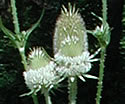 Cut-leaf Teasel plants
Cut-leaf Teasel plants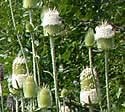 an infestation of Cut-leaf Teasel
an infestation of Cut-leaf Teasel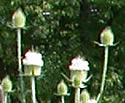 more infestation of Cut-leaf Teasel
more infestation of Cut-leaf Teasel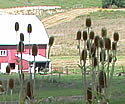 another infestation of Cut-leaf Teasel
another infestation of Cut-leaf Teasel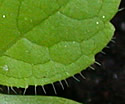 Cut-leaf Teasel seedlings
Cut-leaf Teasel seedlings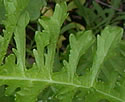 flowering rosette
flowering rosette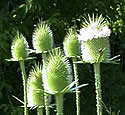 more flowers
more flowers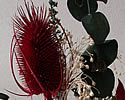 flower arrangement with Cut-leaf Teasel
flower arrangement with Cut-leaf Teasel
Photos courtesy Peter M. Dziuk, taken in Houston County and Roseville, MN
Comments
Have you seen this plant in Minnesota, or have any other comments about it?
on: 2017-11-20 07:56:50
We have been working with MDA through the SWCD office in Wright County to eradicate Common teasel (Dipsacus fullonum) on a County Road right-of-way north of Buffalo. The growth form is very much the same as Cut-leaf but the leaves are not lobed at all. unfortunately , it is obvious that roadside mowing spread this down the ROW since it seems to occur near obstacles like mails boxes, for ~2 miles.
on: 2019-07-09 22:06:58
Note that in the flower arrangement pictured the teasel flowerhead is common teasel, not cutleaf teasel. Notice the length of the sepals.
on: 2020-11-30 23:39:16
I found and reported 2 new Teasel sites this year...confirmed by EDDmaps...one site was about 6 miles from the original infestation.
on: 2022-07-27 20:13:23
Cripes...here we go again...13 plants near original infestation and one big healthy plant down the road 5 miles...reported to MNDOT






